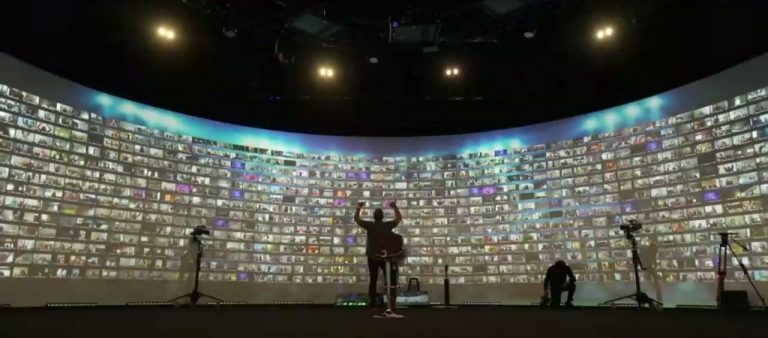7 ways for opening a speech! The ideal speech introduction to grab your audience’s attention
Maybe you know this: you may or must give a speech, but how do you start? Whether you’re giving a speech as an employer or to your colleagues, or you’re an external keynote speaker, the principles are always the same. Likewise, your preparation is not much different: whether it’s a keynote at a kick-off event, the festive speech at the company Christmas party, a motivational speech at a team event or even a laudatory speech at an awards ceremony – the search for the right begining should not be left to chance.
How do you get your audience’s attention so that they want to listen and can follow you easily? How do you sound interesting? In this article you will get the necessary tips for your ideal start for your next speech to inspire your audience. I have collected these speech introductions and examples in my work in the field of public speaking as a presenter and keynote speaker in front of over 5 million people.
Why is the beginning, i.e. the first few minutes of a presentation, so important? This is where the first impression is being made. Your audience intuitively decides within a few seconds whether they like the speaker and want to follow. After that, you still have up to three minutes to pick up your audience with the content of your speech.

Stop guessing how to WOW your audience!
We will send you our secret ingredients to WOW your audience for free! In the MAGIC MOMENTS FORMULA you can learn how to take any audience of any size and create a deep emotional experience for them in order to create a deeper emotional bond with you and your brand.
The first impression is crucial for further success
There’s a saying that goes, “There’s no second chance for a first impression.” It takes between 100 milliseconds and 7 seconds for your audience to get the same impression of you. If you as a speaker fail to make that first impression, no matter how impressive your speech, it will be very difficult to pick up your audience.
US comedian Jerry Seinfeld, one of the most famous American comedians of the 90s, said that his fame only gives him a starting bonus for the first three minutes – at the latest then he has to deliver. If you don’t enjoy the celebrity bonus in your speeches, that means you have to deliver right from the get go to win over your audience.
Requirements for the ideal introduction for your speech
Before you can wow people as a speaker and give any thought to content, you need to set the stage. If you want to give a good speech and move your audience from A to B, two things are essential: you need to know where you want to go and where your audience is coming from.
Know the outcome of your speech
If you don’t know in which direction you want to move your audience, then no amount of tips will get you there. So before you tinker with the ideal introduction, you need to be clear about what your outcome is.

What feeling do you want the audience to have when you leave the stage? What impression do you want to convey as a speaker? Even more public speaking tips you can find here.
Know your audience members
If you want to catch a fish, you have to use a bait that tastes good to the fish, not to the fisherman. The same applies to presentations: who decides what is a top speech? That is, of course, in the eye of your audience. Therefore, it is all the more important to know who the people are, listening to your speech.

An American proverb says that your audience doesn’t care how much you know until they know how much you care. Your audience won’t pay attention to you until they see that your speech is relevant to them. As a speaker, do you bring examples and tips and answer questions in your main points that matter to the audience? Do your main ideas strike a cord?
"There's a saying that your audience doesn't care how much you know until they know how much you care about them. Your audience won't pay attention to you until they see that your speech is relevant to them." Share on XTip: Try to find out as much as possible to know in advance what moves your audience and why people are here today. If you have the opportunity, use the time for successful networking and listen to their needs.
The goal of an ideal introduction to your speech
Only after you know your outcome and your audience you can focus on how to start your presentation, because now you know as a speaker in which direction your ship should sail. If you want to give a speech, you need to get your audience interested in you and your main points. For this to happen, you need the attention of your audience.
Speaker Tip: First create attention, then develop interest in your message and your main points to make it worth listening for your audience.
Giving a speech: seven perfect speech introductions
Now let’s look at tips and examples of how you as a speaker can inspire your audience. These tips should give you a guideline from where you can successfully transition from your chosen introduction to the main part and final part of your speech.
1. He who asks, leads – starting with a question
An elegant way to begin a speech is with a question. The goal is to engage your listener directly in your opening and generate interest. In order for the question to be effective, it must be tailored to your target audience. The question may be provocative, surprising or even make you smile, but it must be relevant.

For example, if you’re speaking to a group of retirees, a question like “Which one of you went to a disco last weekend?” would be just as out of place as asking a group of Wall street brokers “Which one of you has been involved in stocks?”. Your audience needs to feel like you know who you’re dealing with.
“Who remembers what they did last Saturday night?” was an opening I chose many years ago when giving a speech. Of course, after that, there was a story about my Saturday night that fit right in with the theme of my speech. People were immediately involved and everyone was thinking. Because just about everybody did something last Saturday and so it was relevant… even if many didn’t even remember it.
With questions that fit the topics, you are sure to get the attention of the participants. However, always pay attention to what you trigger in your audience with a question and, if requested, also provide the appropriate answer.
Another speaking tip: When you ask a question, give your audience time to respond. Whether out loud, with a show of hands, or silently, people need time for what you say to have an impact. Of course, questions can also be used during your speech.
2. Start your speech with a quote
Using the words of another person in your speech is a proven way. The art of building a good speech is to pick up your audience where they are. A pointed quote that gets to the heart of your ideas or the occasion is the basic premise for choosing someone else’s statement as your lead-in. If people are familiar with the name of the person you are quoting, it gives you added credibility as a speaker.
Very similar to a quote is using a proverb to start your speech. Again, there is often a deeper wisdom behind it. Link this to the idea of your speech and you have a great introduction.
Again, I’ll give you an example from my own experience when I was asked to give a presentation on the topic of corporate mission statements many years ago. I decided to start with a quote, but the number of quotes on this topic are manageable. However, the corporate mission statement compares very well with the soul for people, and so on this occasion I found a quote on the subject of the soul and then drew the analogy with the corporate mission statement. “Outside the box” solutions are also the speaker’s friend.
3. Inspire your audience with storytelling
A particularly powerful way to start is to share a story or personal real life experience with your audience at the beginning of your presentation. With a personal story, you create compelling moments and build an emotional connection with your audience. However, this is also where the biggest danger lies: your story must absolutely correspond to the facts and at the same time should have a connection to the topic of the event. The audience has a good nose for it, if you serve them a “suitably made” story.

Of course, storytelling is not limited to stories you have experienced yourself. You can also draw on a current or even historical event. Important, as mentioned above, is the connection to the goal of your presentation. Also, make sure that you start right in the relevant event and do not begin with Adam and Eve. Especially extroverted people like to get into narration and then it can happen that you lose the drive to your actual presentation and your audience is no longer on the point.
One of my stage coaching clients, for example, took his audience into a situation right at the beginning of his speech when he was at the start of his first triathlon. He immediately built up a tension, because he put his audience directly into it instead of talking about preparation and planning for the triathlon. Because he also found the right tone, the speech went down great.
Bonus tip for your speech: Stories absolutely need to be rehearsed and tailored to your audience and the occasion. This does not mean, as already mentioned, that you add things, but that you leave out unnecessary things. Don’t just tell from memory, but really practice.
4. Start with an open loop
Starting with an open loop is something like the supreme discipline. Here, you start with a story, but don’t finish telling it until the end of your speech. This type of introduction is certainly a bit unusual and, in my opinion, more suitable for experienced speakers, especially to keep the tension high.
You start with the open loop in the same way as with storytelling and take your audience along until the point where the tension is at its highest. Instead of the resolution, you lead into the topic of your speech and then come to the main part, where the content is presented with further examples. Only at the end do you pick up the ball of your introductory story again and close the open loop.
As an example, I start one of my keynote speeches with such an open loop: I take the audience on my experience at the New York City Marathon. Since my preparation for it was far from ideal due to injuries, I wasn’t sure until the start how far I would run that day. My speech started with the thoughts going through my head at the start, with my uncertainty but also anticipation. The start of the marathon was then the Open Loop, which I only resolved at the end of the speech.
5. Enchant the audience with parables
A parable is a very short to short story which might not even have a plot of its own. While a parable can be told with action, as if something has actually taken place, it can also be about something hypothetical: “Imagine…” or “Suppose…”. In both cases, the point is that we want to make a connection to the content.
The purpose of parables is to pick up the audience as they enter your presentation and provide an emotional experience that immediately introduces them to the topic through your words.
6. Facts, figures and statistics as an introduction for the speech
The FFS introduction is particularly useful if you have facts, figures or statistics that are not familiar to your audience and are also unusual. In addition, it must of course fit your topic and possibly support your thesis. A personalized statistic works best to meet your audience’s needs.

When we were designing the outline for one of my Executive Legacy Coaching clients’ investor pitch, we made a conscious decision to start with a number that would probably come as a surprise to many listeners. To back up the pain point that his product solves, he asked the panel how much they thought that an unhappy employee costs a company per year. Starting with that number was so effective because the audience’s estimates were all substantially lower than the true number, creating an a-ha effect.
7. Looking back
Another way to start your speech is with a look back. This variant is particularly suitable if you are to give a speech on the occasion of an anniversary or birthday. In your preparation, you should pay special attention to who is sitting in your audience: what connection do they have to the person or the company or the occasion and, above all, have they experienced the period themselves.
Some time ago, I had the privilege of being on stage at a company’s 20th anniversary. In order to give the audience as emotional an experience as possible, I first had to find out who was in the audience. Have people lived through these last 20 years, and are they likely to remember the moment from 20 years ago? Since my audience was mostly over 35 years old I assumed that was the case. Thus I dove into the world of 20 years ago: how did the world look and what moved people at the time? Immediately the people were in the emotions of the memories and from that I could then draw a bow to the company anniversary: “much has changed, but one thing has remained the same…”.
Giving a speech: here’s what you should avoid when getting started
Jokes are for comedians
There are talented joke tellers and there are those who always flub the punch line. If you feel uncomfortable in the role of the joker, don’t do it. However, that doesn’t mean you can’t spice up the introduction with a little humor. Humor arouses positive emotions and loosens the atmosphere. A humorous introduction, which also works without a joke, signals to the participants that the event will not be dry as dust and that it is worth staying for.
Bonus tip: Humor is different in different regions and works best when you approach your audience with respect and humility.
Stay away from provocative introductions
A provocative introduction is like riding on a razor blade: very dangerous. You have to have an incredible ace up your sleeve to win your audience back. As a rule, I would strongly advise you not to use provocative introductions. If your audience perceives you as an unsympathetic person, no matter how ingenious the content of your speech, it will not bring the desired success.
Start with an apology
Some insecure speaker starts his speech with an apology for his insecurity or God knows what else. Please don’t do that. For one thing, the audience usually doesn’t notice it anyway, and for another, it immediately takes something away from your first impression. You might get sympathy for it, but in the rarest cases you will get the attention for your speech.

One of the most important tips I once received was that your audience wants you to win. That’s right, you read that correctly. Your audience wants you to be good. No one sits in the audience hoping for a boring speaker to come on now. Your audience wants you to do your job well. If you feel anxiety on the way to the stage, keep reading.
The way to the stage and the first seconds
The key to a perfect introduction lies not only in the preparation for your speech, but also in the emotional preparation in the moments before public speaking. Especially if you are nervous or even feel speech anxiety, it is even more important that you, to present convincingly, are in an ideal state.
Take a deep breath just before your performance, send positive emotions to your audience and off you go. Many speakers also like to take index cards with their notes to be prepared in case of an emergency. The phrase for the introduction as well as for the conclusion I would always write in full. For the main points, keywords are enough here.
When you finally arrive on stage, at first be aware of your audience. Before you begin, start with eye contact and confident body language to radiate stage presence. Only then, when you feel the attention of your audience, you start to talk. This confidence will automatically boost your credibility.
Bonus tip: if you’re unsure about your voice, a little voice training will help.
The ideal start for your virtual speech
Of course, the principles for your ideal start also apply at virtual events. So if you hold a webinar or a virtual presentation or are on stage at a hybrid event, nothing will change in the structure of your preparation. The main point in the virtual space is that you have to speak in front of the camera and this should be practiced. The specific elements of structuring your presentation stay the same.

Ask Ronny to coach you for your next performance
Click on the button and send a non-binding request to Ronny to be your coach for your next keynote, speech or presentation.
Feeling ready for your next speech?
In this article you have learned how to start your speech in an ideal way. Do you already have an idea which structure you like best? Remember that you always start with your outcome and your audience before you create a thread for your presentation.

The tone makes the music. Former American writer Maya Angelou summed it up this way: “Your audience won’t remember exactly what you said, but they’ll always remember how it made them feel.” Whatever the occasion, take your audience on an emotional journey.
"The tone makes the music. Your audience won't remember exactly what you said. However, they will always remember how it made them feel. Take your audience on an emotional journey." Share on XIf you feel that you still need help for your next speech or keynote, feel free to contact me or just write me an e-mail! Together many things are easier.
Which introduction appeals to you the most? Which start to a speech have you learned about here and would like to try out for your next performance? Please leave a comment below and share this article with someone who you think will profit from it. All the best for your next speeches.









 Contact
Contact







